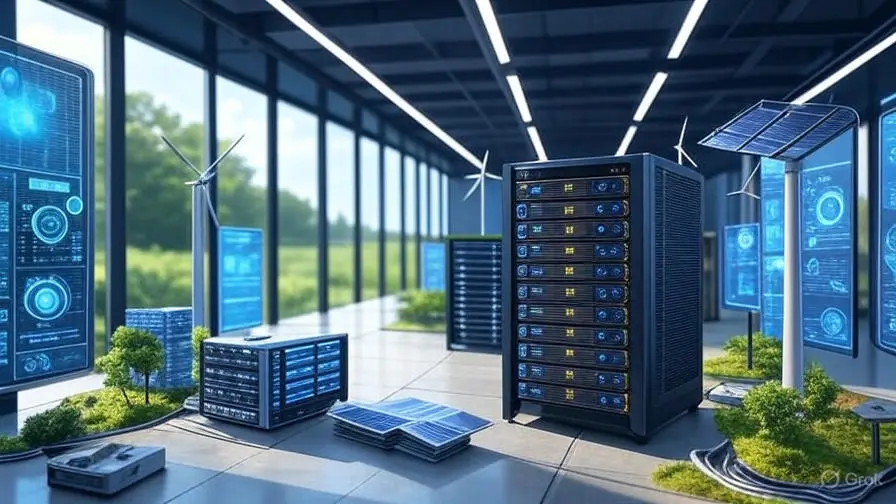Have you ever wondered if the AI that’s powering your daily life—from smart assistants to personalized recommendations—is silently harming the planet? As artificial intelligence continues to integrate into every corner of our world in 2025, its environmental footprint has become a hot topic. While AI drives incredible innovations, it’s also linked to massive energy demands, carbon emissions, and resource consumption. But it’s not all doom and gloom; AI is also a powerful tool for tackling climate challenges. In this balanced exploration, we’ll dive into the facts, figures, and future of AI’s environmental impact, helping you understand the full picture without the hype.
AI’s Growing Thirst for Energy: The Carbon Footprint Dilemma
One of the most discussed aspects of AI’s environmental impact is its enormous energy consumption. Data centers, the backbone of AI operations, are power-hungry beasts. In 2023, these facilities already accounted for about 4.4% of U.S. electricity use, and with AI’s explosive growth, that figure could triple by 2028. Globally, AI-driven data centers are projected to consume up to 1,050 terawatt-hours by 2026, enough to power entire countries.
Why so much energy? Training large AI models like GPT-4 or Grok requires processing billions of parameters, often on specialized hardware like GPUs. A single AI training session can emit as much carbon as five cars over their lifetimes. For inference—the everyday use of AI—the energy toll adds up quickly. Google, for instance, expects to spend $75 billion on AI infrastructure in 2025 alone, highlighting the scale. This surge in demand is straining power grids and contributing to greenhouse gas emissions, especially when data centers rely on fossil fuels.
But let’s put this in perspective. While AI’s carbon footprint is significant, it’s not the sole villain. The tech industry as a whole, including data centers, could account for 18-21% of global energy demand by 2035, factoring in AI. However, many companies are shifting to renewable sources—Google aims for carbon-free energy in all data centers by 2030—to mitigate this.
Water Usage: The Hidden Cost of Cooling AI
Beyond electricity, AI’s environmental impact extends to water resources. Data centers generate immense heat, requiring vast amounts of water for cooling. A single large data center can use as much water as a small city—up to 360,000 gallons per day. In arid regions like the U.S. Southwest, this competes with local water supplies, exacerbating shortages during droughts.
For generative AI, the water footprint is staggering. Training a model like GPT-3 consumes enough electricity to evaporate thousands of liters of water through power plant cooling. Even simple AI queries add up: a median text prompt on Gemini uses 0.24 watt-hours, but scaled across billions of users, the cumulative water impact is notable. In 2025, as AI demand grows, data centers’ water use is expected to rise, prompting calls for more efficient cooling technologies like liquid immersion or air-based systems.
It’s worth noting that not all data centers are equal. Hyperscale facilities in cooler climates use less water, and innovations like Microsoft’s underwater data centers aim to reduce this footprint entirely. Still, the overall trend underscores the need for sustainable practices in AI infrastructure.
E-Waste and Resource Extraction: The Hardware Side of AI
AI’s environmental toll isn’t just operational—it’s also in the hardware lifecycle. GPUs and servers, essential for AI, contain rare earth metals like tantalum and cobalt, mined in ways that often degrade ecosystems and exploit labor. The rapid obsolescence of AI hardware leads to mounting e-waste; in 2024, the tech sector generated 62 million tons of electronic waste globally, with AI contributing a growing share.
Disposing of these components releases toxic substances like lead and mercury into the environment, contaminating soil and water. Recycling rates remain low—only 20% of e-waste is properly handled—exacerbating the problem. As AI models require more powerful chips, the cycle accelerates, with companies like NVIDIA producing new generations every few years.
On a positive note, some firms are adopting circular economy principles. Apple, for instance, uses recycled materials in its AI hardware, and initiatives like the EU’s Right to Repair laws are pushing for longer-lasting devices. These efforts could slow the e-waste surge if scaled up.
The Positive Side: How AI Can Help the Environment
While AI’s environmental impact is often framed negatively, it’s also a powerful ally in sustainability. AI optimizes energy use in smart grids, reducing waste by up to 15% through predictive maintenance. In conservation, AI monitors wildlife via camera traps and drones, aiding in biodiversity preservation and anti-poaching efforts.
For climate modeling, AI processes vast datasets to predict weather patterns and natural disasters more accurately, helping governments prepare and mitigate damage. A 2025 study suggests AI could reduce global emissions by 3.2 to 5.4 billion tonnes annually by optimizing renewable energy projects and resource management. Companies like IBM use AI to track deforestation, while Google applies it to improve data center efficiency, cutting cooling energy by 40%.
This dual nature—problem and solution—highlights AI’s potential. If harnessed responsibly, AI could offset its own footprint by enabling greener technologies and behaviors.
Mitigation Strategies: Making AI More Sustainable
Addressing AI’s environmental impact requires proactive steps. First, optimize models for efficiency. Techniques like model compression reduce computational needs without sacrificing performance, cutting energy use by 20-30%. Shifting to renewable energy for data centers is another key move—Microsoft and Amazon are leading with carbon-neutral commitments.
Regulatory frameworks are emerging. The EU’s AI Act mandates environmental reporting for high-risk systems, pushing transparency. Businesses can adopt «green AI» practices, such as using edge computing to minimize data transfer emissions.
On a personal level, users can choose eco-friendly AI services or advocate for sustainable tech. Tools like Carbon Footprint Calculators for AI queries help raise awareness. Collective efforts could limit AI’s footprint while amplifying its benefits.
The Future Outlook for AI and the Environment
Looking ahead, AI’s environmental impact could intensify or improve, depending on our actions. Data centers might consume 21% of global energy by 2030 if unchecked, but AI-driven efficiencies could offset this by optimizing energy use across sectors. Innovations like neuromorphic computing, mimicking brain efficiency, promise to slash AI’s power needs by orders of magnitude.
Global collaboration is key. Initiatives like the UN’s AI for Good program promote sustainable AI, while tech giants invest in carbon capture. By 2030, AI could help achieve net-zero goals if prioritized ethically. The challenge is balancing innovation with responsibility—ensuring AI’s growth doesn’t come at the planet’s expense.
Wrapping Up: Navigating AI’s Environmental Path
The environmental impact of artificial intelligence is a complex story of costs and contributions. From soaring energy demands and water use to e-waste concerns, AI’s footprint is undeniable. Yet, its role in driving sustainability—through smarter resource management and climate solutions—offers hope. As we move forward in 2025 and beyond, the key is mindful adoption: optimizing AI for efficiency, embracing renewables, and pushing for ethical practices.
Whether you’re a tech user wondering about your daily AI interactions or a leader shaping policy, staying informed is crucial. AI isn’t going away—it’s evolving, and so must our approach to its environmental effects. What steps will you take to make your AI use greener?
(Word count: 1523)
Frequently Asked Questions
What is the main environmental concern with AI?
AI’s primary impact is high energy consumption in data centers, leading to significant carbon emissions.
How does AI contribute to e-waste?
Rapid hardware upgrades for AI generate electronic waste containing toxic materials.
Can AI help reduce its own environmental impact?
Yes, AI optimizes energy use in data centers and supports renewable energy projects.
What are some ways to make AI more sustainable?
Use efficient models, renewable energy, and regulatory frameworks to minimize footprint.
Is the environmental impact of AI worsening?
It could increase with growth, but innovations like green computing may mitigate it.



